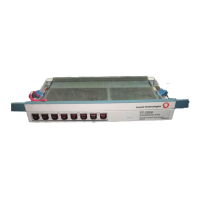Control, Transmission, and Synchronization Interfaces
Issue 8.0 July 2002
5-27
Bidirectional Ring Applications 5
General 5
A bidirectional ring consists of up to 16 nodes, and each node has several
synchronization provisioning options possible. This section contains a complete
set of rules for determining how the synchronization mode should be provisioned
for each node.
In addition to providing high quality, protected transmission, an FT-2000 ring can
also be used to distribute timing signals from BITS clocks to other BITS clocks
using the OC-48 signal. Distributing timing signals to BITS clocks using the
FT-2000 OC-48 Lightwave System is becoming an increasingly important
additional application to the transmission function. This is because the OC-48 line
is a higher quality medium than direct T1 lines currently used to distribute timing
signals or T1 facilities carried in the payload of SONET systems. (SONET
payloads carrying T1 facilities cannot be used to distribute timing in rings.)
However, there are many good quality synchronization distribution networks in
place using T1 facilities that users may not wish to convert. Therefore, the
FT-2000 OC-48 Lightwave System may or may not be used for distributing timing
signals. The user must decide if the FT-2000 ring will be used to distribute timing
signals to BITS clocks. This distinction is necessary to ensure that the nodes in
the ring are provisioned properly to prevent closed timing loops during protection
switching operations.
Prior to FT-2000 OC-48 ADR Release 7.2, network configurations could only use:
(a) free running, (b) external timed, or (c) through timed synchronization modes.
With Release 7.2 line timed synchronization mode is available. Reconfiguring a
customer's network to support this mode is optional, but it is recommended. A
combination of through timed and line timed in the same ring should only be used
temporarily during the upgrade/reconfiguration process. During normal operations
the ring should be configured for either all through timed or line timed with 2 nodes
externally timed.
NOTE:
Bidirectional line switched rings, as an option, may or may not be used to
distribute timing.

